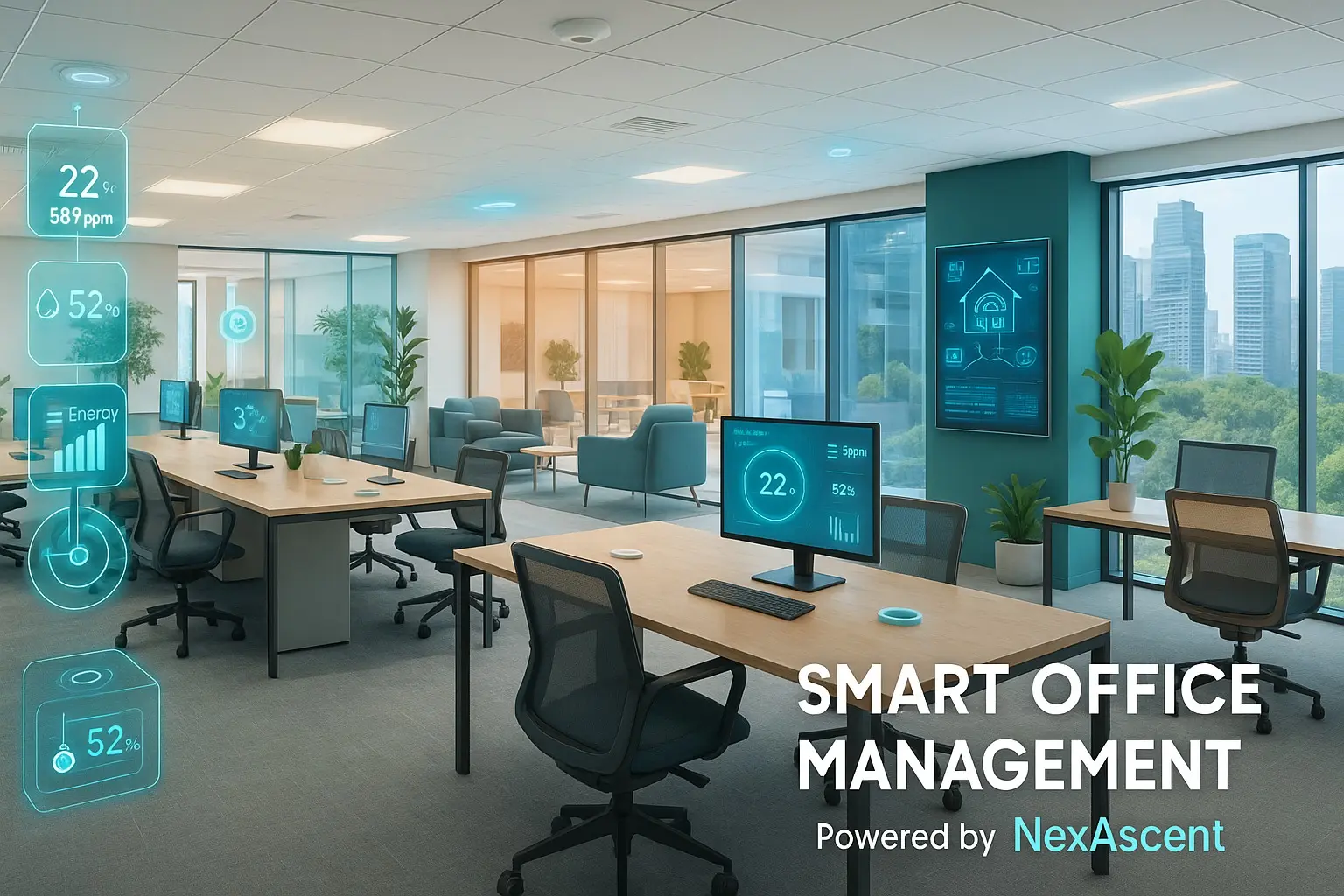7 Key Benefits for Smart FM – IOT Sensors for Energy Efficiency and Tenant Comforts in Office Buildings Singapore

IoT sensors for energy efficiency and tenant comforts in office buildings Singapore are revolutionizing how facilities manage sustainability, comfort, and operational costs. With Smart FM practices, LoRaWAN connectivity, and data-driven ACMV optimization, buildings can reduce energy consumption, enhance comfort, and align with BCA Green Mark and NEA Smart FM standards.
NexAscent’s end-to-end IoT ecosystem integrates Milesight sensors — from VS135 People Counters to WT304 Thermostats — providing measurable improvements in both energy efficiency and occupant well-being.

Why IoT Sensors for Energy Efficiency and Tenant Comforts Matter in Singapore
In Singapore, ACMV systems consume up to 60% of total building energy, making them a prime target for optimization.
Traditional fixed-schedule cooling and lighting lead to:
- Over-cooling during low occupancy
- Inconsistent comfort across zones
- Higher electricity bills and carbon emissions
By deploying IoT sensors for energy efficiency and tenant comforts in office buildings Singapore, facility managers gain real-time visibility of temperature, CO₂, humidity, and usage — enabling dynamic control of ACMV and lighting systems.
Top 7 Benefits of IoT Sensors for Energy Efficiency and Tenant Comforts in Office Buildings Singapore
| Goal | IoT Function | Impact |
|---|---|---|
| Energy Optimization | Automated ACMV and lighting control | 20–35% energy savings |
| Occupant Comfort | Real-time CO₂ and temperature balance | Healthier, more productive workspace |
| Predictive Maintenance | Continuous ACMV performance data | Fewer breakdowns, longer asset life |
| Sustainability | Measurable ESG and Green Mark metrics | Supports BCA certification |
| Operational Transparency | IoT dashboards and reports | Data-based decision making |
| Operational Transparency | IoT dashboards and reports | Data-based decision making |
| Scalability | LoRaWAN connectivity | Cost-effective expansion |
| Tenant Retention | Comfort analytics and feedback loops | Improved satisfaction and loyalty |
IoT Sensors for ACMV Control and Energy Efficiency
| Sensor Type | Example Device | Function |
|---|---|---|
| CO₂ / IAQ Sensor | AM103 / AM319 | Measures CO₂, temperature, humidity, PM2.5, VOCs |
| People Counter | VS135 | Counts entries/exits per floor to adjust ACMV based on crowd density |
| Room Occupancy Sensor | VS121 / VS321 | Detects motion and presence in meeting rooms |
| Desk Utilization Sensor | VS340 / VS341 | Monitors workspace usage for space optimization |
| Smart ACMV Thermostat | WT303 / WT304 | Controls FCUs for precise temperature regulation |
| Energy / Power Meter | CT10X / UC300 | Tracks current, voltage, and energy consumption |
| Lighting / Lux Sensor | WS202 | Adjusts lighting intensity by daylight |
| Gateway | UG65 / UG56 | Connects sensors securely via LoRaWAN |
By combining these IoT sensors for energy efficiency and tenant comforts in office buildings Singapore, facility managers can automate both light and cooling systems with real-time occupancy and IAQ data.

How IoT Sensors Improve Energy Efficiency and Comfort in Smart Offices
- Real-Time Data Collection: Sensors monitor CO₂, temperature, occupancy, and energy use continuously.
- Dynamic ACMV Control: WT304 thermostats and VS135 people counters adjust cooling intelligently.
- Smart Lighting Automation: WS202 sensors dim lights when sufficient natural light is detected.
- Predictive Maintenance: UC300 meters detect anomalies before faults occur.
- Unified Dashboard: NexAscent’s platform visualizes energy trends, comfort scores, and efficiency KPIs in real time.
Integration of IoT Sensors with Building Management Systems (BMS)
IoT sensors for energy efficiency and tenant comforts in office buildings Singapore integrate seamlessly via MQTT, Modbus, or BACnet gateways, offering:
- Enhanced visibility of zone-level comfort and energy consumption
- Cloud-based control and analytics
- Maintenance forecasting and compliance reporting
NexAscent’s dashboard bridges real-time sensor data with actionable insights for facility managers and tenants.

Measurable Results and Green Mark Compliance
| Metric | Typical Improvement |
| Energy Use | 20–35% reduction |
| IAQ (CO₂ & PM2.5) | 25–40% improvement |
| ACMV Runtime | 25% reduction |
| Tenant Comfort | +30% satisfaction |
| ESG Reporting | Automated data export |
These outcomes align directly with BCA Green Mark 2021 standards for Smart and Sustainable Buildings.
Implementation Roadmap (4–6 Weeks)
| Phase | Description |
| 1. Site Assessment | Evaluate ACMV zones, IAQ hotspots, and network layout |
| 2. Deployment | Install WT304 thermostats, VS135 counters, and IAQ sensors |
| 3. Dashboard Setup | Configure real-time monitoring and alerts |
| 4. Training | Train FM staff to interpret data and optimize schedules |
| 5. Optimization | Adjust cooling profiles and thresholds based on analytics |
Why Choose NexAscent for IoT Sensors in Office Buildings Singapore
NexAscent offers complete IoT solutions for energy efficiency and tenant comforts in office buildings Singapore, built on proven deployments across smart malls, campuses, and commercial towers.
We deliver:
- End-to-end IoT and AI integration for ACMV and IAQ
- Custom dashboards for Green Mark and ESG reporting
- LoRaWAN infrastructure and setup for large buildings
- Local technical support under Singapore’s Smart FM ecosystem
Conclusion: Smart Offices Powered by IoT Sensors in Singapore
The future of smart offices lies in IoT sensors for energy efficiency and tenant comforts in office buildings Singapore.
Contact NexAscent to build your Green Mark-ready smart building solution today.
